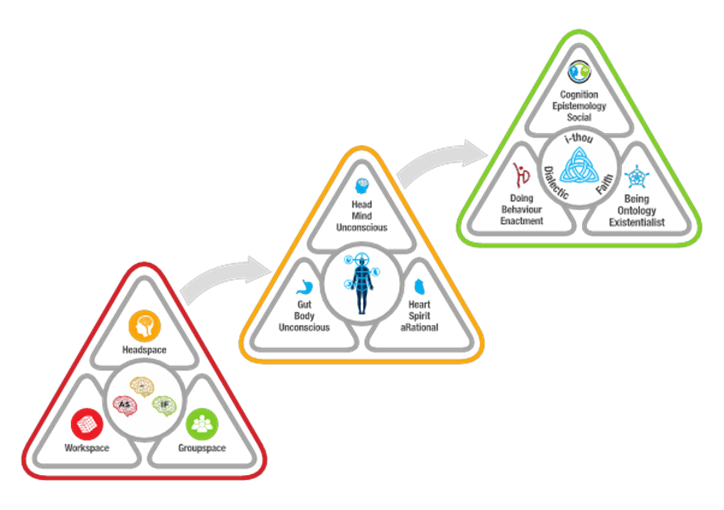One of the foundations of methodology in SPoR is triarchic thinking. Triarachic thinking understands the social world (Socialitie) in dialectic (dialogue). That is, there is something happening in the space between you and me, I and it, us and them. This is best represented by using a hyphen eg. i-thou, if-then, us-them. In SPoR we have very little interest in binary thinking and often use text that is hyphenated eg. Following-Leading (https://www.humandymensions.com/product/following-leading-risk/). The hyphen in this case demonstrates the inseparable nature between following and leading.
In risk and safety texts on so-called ‘leadership’ the emphasis is most often about qualities that exists in the leader or about a lack of quality exhibited by a follower. This is not how SPoR understands leadership instead, leadership is discovered (learned) in the hyphen, what happens between the leader and follower. It is in the hyphen that we discover intercorporeality (what we share in common) and interaffectivity (how we affect each other). This was demonstrated well by Fuchs (https://www.academia.edu/30974462/Intercorporeality_and_Interaffectivity). This space between persons is the space of Socialitie where mutual resonance is felt. We know what others feel by intuition, body memory and mirror neurons. This is most often how we develop a ‘shared understanding’. Shared understanding is not some concocted idea of cognitive agreement.
We don’t know each other by brain computer-like processing, we know each other by felt knowing. (https://www.klinikum.uni-heidelberg.de/fileadmin/zpm/psychatrie/fuchs/The_Brain_-_A_Mediating_Organ.pdf). We don’t know each other by abstract ideas and analysis, we shake hands, we make eye contact and we listen. This is why analysis in safety is far less effective than walking the job and listening to people (not telling and not controlling). This is why the engineering-mindset in safety who write about culture, find it confusing (Busch), abusive (Hopkins) and ‘cloudy’.
In SPoR, we often discuss triarchic methodology and use mandala symbolism (https://archive.org/details/mandalasymbolism00jungrich) to help understand what happens dialectically in social relations. The notion of dialectic is about the dialogue that happens in the space between people, the in-between. The centre of a mandala symbolises this in-between. This is what Buber called ‘meeting’. Unfortunately, in safety, there are many ‘meetings’ but no ‘meeting’. How can there be real ‘meeting’ between persons when the purpose of safety is the control of objects?
This is why in SPoR we use arrows in iCue engagement (https://safetyrisk.net/icue-listening-engagement-manual/) to convey relationship between things, objects, people and groups. The only way to envision social relationships in investigations or risk assessment is to map visual and verbal interactions. This is what iCue does (https://safetyrisk.net/understanding-icue-a-visual-verbal-semiotic-method-for-tackling-risk/). And it works (https://www.humandymensions.com/product/it-works-a-new-approach-to-risk-and-safety/ ).
When you first are introduced to SPoR (https://safetyrisk.net/introduction-to-spor-free/) you learn about Workspace, Headspace and Groupspace (WS, HS, GS) and One Brain Three Minds (1B3M). Both these methods are foundational and ground-breaking. These are easy to learn and help people unlearn many of the myths that infuse safety with delusions of certainty and control. At a higher level of understanding are personhood issues that underpin WS, HS, GS and 1B3M these are about the nature of human embodiment, knowing and decision-making.
At the highest level are methodological issues that drive the method of WS, HS, GS and 1B3M and ensure their integrity. These higher forms of knowing are openly declared in SPoR but need not be evident at the time of learning the effectiveness of WS, HS, HS and 1B3M. This is represented in the Model at Figure 1. SPoR a Triarchic Methodology.
Figure 1. SPoR a Triarchic Methodology
Why does this matter?
First of all, it is important to understand that SPoR does not use behaviourist, binary or engineering methods to explain worldview. SPoR uses Semiotic and Poetic methods to explain the phenomenon of persons, social relations and risk. This is not just different in name but different in practice. Unless there is a foundational difference in philosophy, there is no difference in method. Methods are the outworking of a methodology and hopefully that methodology is made open, transparent and visual.
One can composite any collection of slogans about safety and risk but if at the foundation it continues to be about the efficiency of systems, then there is no difference. If the language remains about the measurement of performance, then there is no difference.
Unfortunately, in safety, nothing has changed since Heinrich. The same concocted mythology remains constructed on the same mechanistic worldview. Indeed, Heinrich is still being taught in safety curricula everywhere despite the fact that it is a hoax (https://safetyrisk.net/ration-delusions-and-heinrichs-hoax/), delusion (https://safetyrisk.net/hoodwinked-by-heinrich/) and a con (https://safetyrisk.net/the-heinrich-hoodoo/ ). The reason why the myths of Heinrich prevail after 70 years is because safety wants to believe it. Belief in Heinrich is an act of faith. There is no evidence to substantiate any of the extremist claims this salesman made so long ago. Similarly for the models James Reason put forward and all they do is re-badge Heinrich.
None of this stuff is real and bears no reflection on how people really make decisions.
Yet, Heinrich language sets up a beautiful foundation for behaviourist judgmentalism and the adoration of zero, what is well known as ‘the safety comfort zone’. From this methodology Safety leaps to joy in the control of hazards, even psychosocial ‘hazards’.
Yet, when one moves away from the binary world of behaviourist safety into a triarchic understanding of ‘meeting-persons’, everything changes. Such ‘meeting’ is where care and helping happens (what safety is so silent about), where the humanisation of risk happens and an ethic of risk is enacted. When one moves away from zero, safety improves. When one moves away from behaviourism, brutalism ceases. When one adopts a triarchic orientation, meeting happens, fear diminishes and engagement happens. This is what the practical, positive and constructive methods of SPoR offer.




Do you have any thoughts? Please share them below